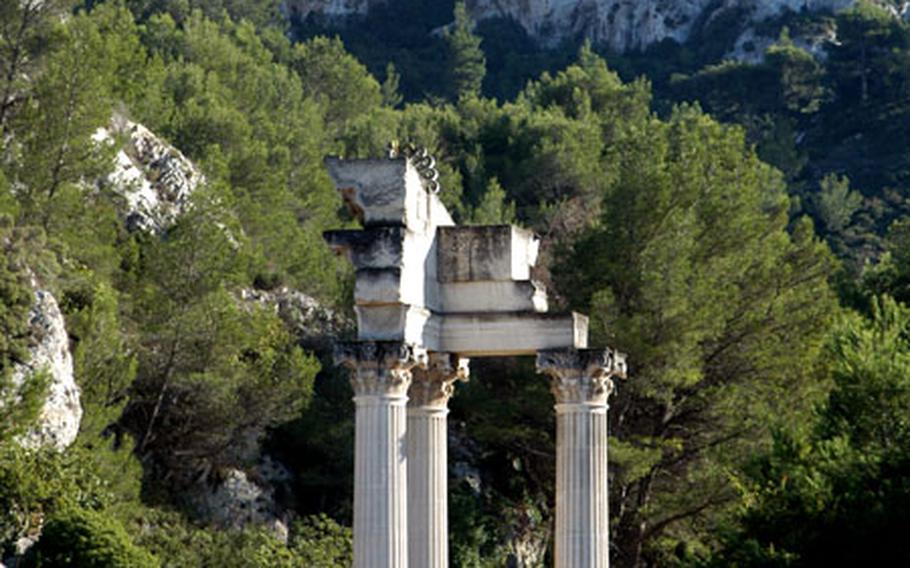
The craggy Alpilles tower over Glanum, the archaeological site on the outskirts of St. Rémy, considered the gateway to the region. (Michael Abrams / S&S)
From afar, the barren limestone peaks look like a lofty mountain range.
Rising from the plains, they could be mistaken for their big brothers, the Alps. Even their name sounds similar. But at their highest, around 1,600 feet, the Alpilles are a far cry from the soaring giants to the east.
But they still offer dramatic vistas, winding roads, caves and mountaintop towns.
As dramatic as these jagged peaks are, it is at the foot of the hills and in their valleys where the heart and soul of the Alpilles lie: in the vineyards, olive groves and fruit orchards.
It is a land of poets and painters, a countryside dotted with thick-walled Provençal farmhouses, known as mas, and medieval villages.
The town of St. Rémy, with its Gallo-Roman ruins, is the gateway to the Alpilles, and the hilltop village of Les Baux is its crown. Only about 15 miles long, much of the Alpilles can be seen in little more than a day, but there is a feeling here — a joie de vivre — that makes one want to while away the days in its midst.
St. Rémy makes a good base for exploring the region, but even if you are staying in Arles, Nîmes or in the Luberon, there is a nice circular route that will take you to the sights of the Alpilles.
Beginning at St. Rémy, head east on D99 toward Cavaillon, then south on D74A toward Eygaliéres. On the road, you pass the Mas de la Brune, a country residence that is now a hotel. Here you will find Le Jardin de l’Alchimiste, or the alchemist’s garden, a landscaped garden containing many plants of the Mediterranean region and the Alpilles. (The garden is open May to October on weekends and holidays).
Farther on, the medieval town of Eygaliéres crawls up a hillside to its castle. Not far from here, to the east, the 12th-century Chapelle St.-Sixte stands on the site of an earlier pagan temple.
Head back through Eygaliéres, and take D24 south to Le Destet, and then drive west toward Maussane-les-Alpilles. Here the road passes through olive groves and fruit orchards.
In Maussane-les-Alpilles, a typical Provençal village lined with cafes and restaurants, you will find a Santon museum. Santons are figurines once used for Nativity scenes and at first limited to biblical figures. Now there are Santons from all walks of Provençal life — farmers, shepherds, market women, boule players and even Vincent van Gogh. They come in all sizes and can be very detailed and expensive, but are unique souvenirs of Provence.
Next head north on D5 toward Les Baux, crowning the hill in the distance. If you have only one day for the Alpilles, now is the time to visit the ancient town. Even if you decide to leave it for another day, follow D27 toward Les Baux through the vineyards. The area has its own appellation, Baux-de- Provence, and vintners welcome guests to try (and buy) their wines. A wine cellar in French is a “cave,” and one vintner has his cave in an actual cave (a former quarry) in a hill in the Val d’Enfer across from Les Baux.
Not only does Les Baux have its own appellation for wine, it also has one for olive oil made in the area.
After Les Baux, follow D78 toward the village of Paradou, where the Provençal poet Charloun Rieu is buried. Heading toward Arles and Fontvielle, look for signs to “aqueduc romain.” The remains of the Roman aqueducts are down a footpath, a short hike from the sign.
When D78 crosses D33, take a right toward Fontvielle. Before you get to town you will see the Moulin de Daudet, Daudet’s Mill, on the outskirts. It is named after French author Alphonse Daudet, who never actually lived in the mill, but used it as the inspiration for his “Lettres de mon Moulin” (“Letters from My Mill”) a series of letters and tales from Provence.
Farther up D33, surrounded by olive and pine trees, is the Chapelle St. Gabriel, a 12th-century chapel with a fine adorned facade. From here,take D32 back to St. Rémy.
One tip: Before starting the journey, stock up on local cheese, sausages, French bread and something to drink, and enjoy a Provençal picnic along the way.